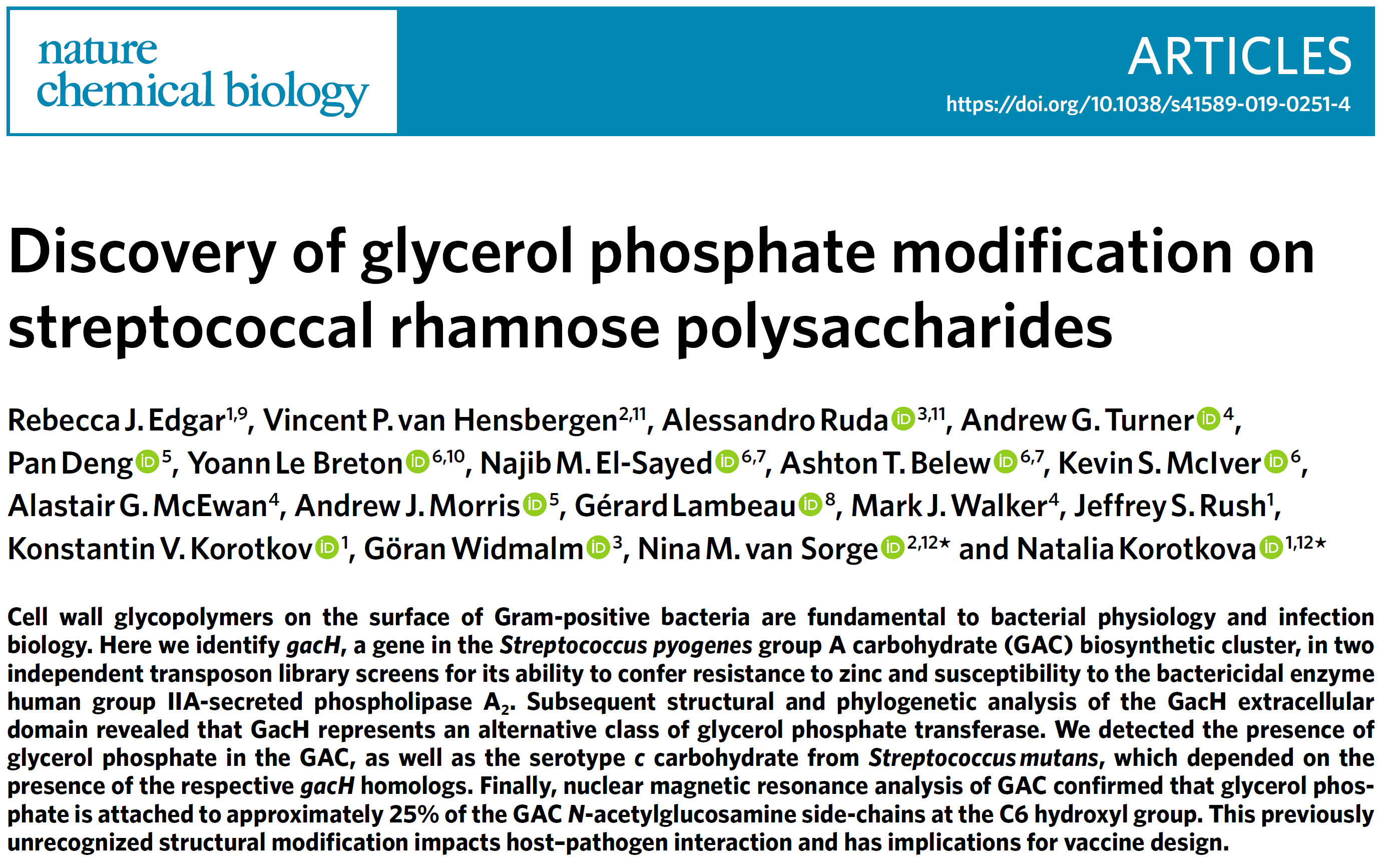博文
新研究确定了甲型链球菌疫苗的潜在靶点
|||
新研究确定了甲型链球菌疫苗的潜在靶点
诸平

据《自然化学生物学》(Nature Chemical Biology)杂志网站2019年4月1日报道,5国10多位研究人员合作完成的一项新研究确定了甲型链球菌疫苗的潜在靶点——Rebecca J. Edgar, Vincent P. van Hensbergen, Alessandro Ruda, Andrew G. Turner, Pan Deng, Yoann Le Breton, Najib M. El-Sayed, Ashton T. Belew, Kevin S. McIver, Alastair G. McEwan, Andrew J. Morris, Gérard Lambeau, Mark J. Walker, Jeffrey S. Rush, Konstantin V. Korotkov, Göran Widmalm, Nina M. van Sorge, Natalia Korotkova. Discovery of glycerol phosphate modification on streptococcal rhamnose polysaccharides. Nature Chemical Biology , Published 01 April 2019. DOI: https://doi.org/10.1038/s41589-019-0251-4
大多数人认为“链球菌性咽喉炎”是一种相对良性的感染,通过一轮抗生素和几天的休息就可以治愈。但是引起链球菌咽喉炎的细菌——A组链球菌(Group A Streptococcus)——也会导致许多更危险的疾病,包括风湿性心脏病和中毒性休克综合征。
随着对抗生素耐药性增加的担忧,科学界所迫要找到治疗A群链球菌等细菌的新方法。一个有美国、荷兰、澳大利亚、瑞典以及法国的10多位研究人员组成的国际科学家联合小组,似乎已经对这种微生物敌人有了一些了解,并希望研制出一种疫苗。
A组链球菌有一层厚厚的细胞壁,可以保护它免受环境危害,包括来自我们自身免疫系统的攻击。这种细菌对人类的抗菌保护机制具有显著的耐药性,但是,其原因尚不清楚。
由美国肯塔基大学(University of Kentucky)的Natalia Korotkova和荷兰的乌得勒支大学(Utrecht University)的Nina Van Sorge领导的研究小组想知道:细菌细胞壁中是否存在可以利用的“弱点”?研究小组用锌离子和人类IIA组分泌的磷脂酶A2(zinc ions and human group IIA secreted phospholipase A2)两种抗菌剂轰击A组链球菌,以确定产生耐药性的基因。他们发现,这两种测试都发现了同一个罪魁祸首:gacH基因(gacH gene)。
该研究团队的十几名来自五个国家的科学家,每一个研究人员都有不同的专业背景知识,他们通力合作,取长补短,使用各种生物化学方法、结构分析方法等,进一步破译这个基因的功能,确定a组链球菌可以增强其抵抗人体防御系统的攻击,是通过磷酸甘油酯(glycerol phosphate)修改细胞壁甘油聚合物(glycopolymers)。
通讯作者之一Korotkova说:“这种以前未被识别的链球菌细胞壁修饰,会影响宿主和病原体之间的相互作用,因此可能是疫苗设计中一个非常有吸引力的目标,特别是因为gacH基因广泛分布在a组链球菌和相关细菌的基因组中。”研究小组采用最先进的核磁共振方法和质谱分析,使这一修改得到证实。Korotkova说:“由于在制备过程中发生了损失,这种甘油磷酸酯修饰几十年来一直没有引起人们的注意。”由于A型链球菌是世界上导致传染病死亡的十大原因之一,疫苗的潜在影响是巨大的,特别是在资源和获得卫生保健的途径有限的地方。Korotkova说:“我们需要更多的研究来证明这种甘油磷酸酯修饰的共聚物可以作为一种安全有效的甲型链球菌疫苗的组成部分。” Korotkova是美国肯塔基大学医学院分子和细胞生物化学系的研究人员。更多信息请注意浏览原文或者相关报道:
Research Published in Nature Chemical Biology Identifies Potential Target for Strep A Vaccine
Abstract
Cell wall glycopolymers on the surface of Gram-positive bacteria are fundamental to bacterial physiology and infection biology. Here we identify gacH, a gene in the Streptococcus pyogenes group A carbohydrate (GAC) biosynthetic cluster, in two independent transposon library screens for its ability to confer resistance to zinc and susceptibility to the bactericidal enzyme human group IIA-secreted phospholipase A2. Subsequent structural and phylogenetic analysis of the GacH extracellular domain revealed that GacH represents an alternative class of glycerol phosphate transferase. We detected the presence of glycerol phosphate in the GAC, as well as the serotype c carbohydrate from Streptococcus mutans, which depended on the presence of the respective gacH homologs. Finally, nuclear magnetic resonance analysis of GAC confirmed that glycerol phosphate is attached to approximately 25% of the GAC N-acetylglucosamine side-chains at the C6 hydroxyl group. This previously unrecognized structural modification impacts host–pathogen interaction and has implications for vaccine design.
Trending
Altmetric
Site-specific ubiquitylation and SUMOylation using genetic-code expansion and sortase
Discovery of glycerol phosphate modification on streptococcal rhamnose polysaccharides
Analysis of modular bioengineered antimicrobial lanthipeptides at nanoliter scale
https://blog.sciencenet.cn/blog-212210-1171514.html
上一篇:食用少量的红肉和加工肉类可能会增加死亡的风险
下一篇:敛财期刊最新一览表